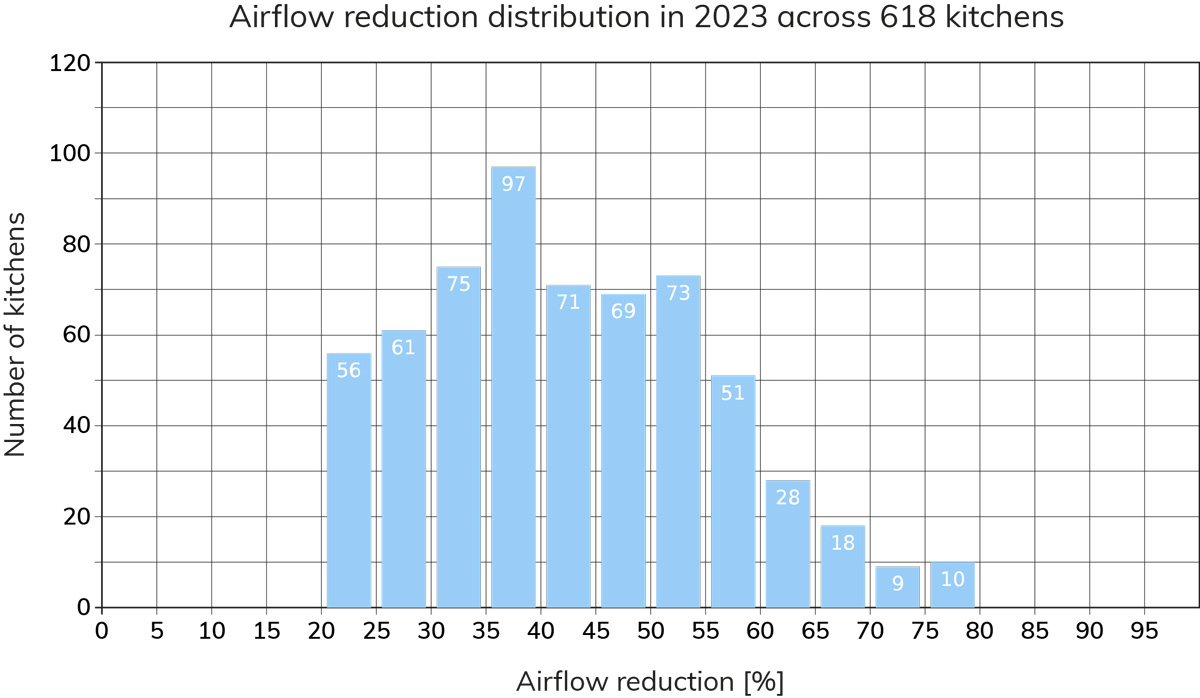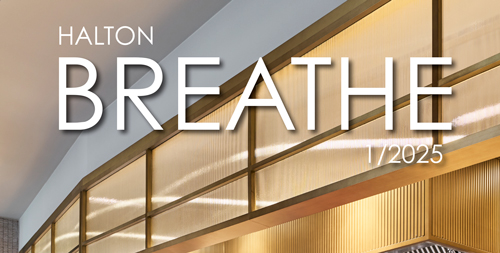
The need for ventilation is high in professional kitchens: often 2–3 cubic meters per second, sometimes even two or three times more. Steam, heat, and small particles must be removed from the room. This consumes large amounts of energy.
“Few people understand how energy-intensive commercial kitchens actually are. This is a kind of blind spot in the real estate domain,” says Halton’s sales manager Jere Kaistinen.
Ventilation fans consume electricity when they rotate. But even more, ventilation has an indirect effect, through heating energy. In cold weather, the same amount of incoming replacement air must be heated as is removed from the building. In hot weather, when air condition is used, the replacement air must be cooled.
Due to the exceptionally strong ventilation, professional kitchens are in a special position compared to other commercial premises.
“Kitchens should be understood as demanding process spaces, such as welding shops or hospital clean rooms,” says Kaistinen.
Over 75 percent savings
Traditional on-off ventilation is used in most restaurants and other professional kitchens. It is started in the morning when the lights are turned on, and it blows at full power until the evening. Usage is typically, for example, 12 hours a day.
If we assume that the ventilation power is 3 cubic meters per second, that means almost 130,000 cubic meters per day and 3,900,000 per month.
“It’s like leaving the water tap running all day long, even though you only need water occasionally. Yet perhaps 95 percent of new restaurants choose to install such traditional system. It’s a bizarre phenomenon in this time, where the energy consumption and climate impact of real estate is on everyone’s lips.”
The modern solution is demand-based ventilation, which adjusts the power of the fans precisely according to what is happening in the kitchen. The power variation is based on the data produced by various sensors and thermal cameras. The sensors measure, for example, the heat and humidity of the room air and the temperature of the exhaust air. Thermal cameras installed in the hood monitor changes in the surface temperatures of the kitchen equipment.
Based on the collected data, the automation system calculates in real time how much supply and exhaust air is needed in different situations. For example, when frozen steaks are placed on the grill, thermal cameras detect it. The damper opens and the power of the fans increases, and the cart is absorbed into the exhaust duct. After frying, the power is reduced. Everything happens automatically.

Halton Connect remote monitoring covers more than 3,700 smart hoods in 39 different countries. The data shows that automated demand-based ventilation cuts air volumes by up to 75 percent compared to a traditional solution.
“It is important to note that the relationship between power and electricity consumption in ventilation fans is not linear. According to the rule of thumb, reducing the power from 100 percent to 50 percent cuts consumption by 75 percent. It means that even a small drop from full power is significant in the long term,” says Kaistinen.
How much does on-demand ventilation save energy? A good understanding is provided by the Halton Connect remote monitoring system, which monitors the professional kitchens of 618 Halton customers in 39 different countries. Altogether 3,719 hoods are connected to the system.
On average, the system has reduced air volumes in these kitchens by 43 percent. In some locations, even 75 percent is reached. The electricity savings of the fans was on average 81 percent. The reference is traditional static ventilation. The data is from 2023.
Let’s make an example calculation based on the average number (43 percent) for a restaurant located in Helsinki. The air changes 3 cubic meters per second for 12 hours every day throughout the year. An automated M.A.R.V.E.L. system will be installed in the kitchen as needed. The results per one year:
• Air volume is reduced by 43%
• Electricity consumption of fans 17,556 3,336 kWh, or 81%
• Heating energy demand 70,740 40,322 kWh, or 43%
• Cooling energy demand 600 342 kWh, or 43%
• Total energy savings 88,896 44,000 kWh or 51%
As can be seen from the numbers, the need for heating energy is about four times compared to the energy needed for fans. It’s because the replacement air coming in has to be heated (3 cubic meters per second). For this reason, the also the savings are greatest in heating.
The cost savings expressed in percentages are the same as above. In euros, the savings vary depending on the price of electricity and the type of heating system in use. Large kitchens save tens of thousands of euros annually.
“Payback period is less than five years”
Demand controlled ventilation was chosen for the new Food Port food court of the Redi shopping center in Helsinki. An important reason was saving energy.
“Halton’s hood consumes less energy because its power changes according to the load. Our savings in operating costs are about 30 percent compared to a traditional system. Thanks to the energy savings, the payback period is a little less than five years,” says real estate engineering consultant Tapani Nousiainen. He is responsible for coordinating the design and execution of Redi’s building technology.
Nousiainen has served in a similar role for several large shopping centers in the capital region. Over the years, he has seen that energy efficiency is a growing trend in this sector.
“Some 15 years ago, there was little interest. Now the situation is different. Owners of large properties want to invest in green technology. It is not only a sensible investment, but also an image issue,” says Nousiainen.
The technical challenge of Redi’s Food Port was that the restaurants replaced regular shops. The ventilation had to be increased almost tenfold. It required new ducts, three new ventilation machines, and a new engine room.
“Another challenge was that the kitchens are located in the middle of the shopping center. Under no circumstances should dirty exhaust air go to the wrong places.”
According to Nousiainen, the possibility of remote monitoring supported choosing Halton as the equipment supplier. Remote monitoring helps maintenance of the property and frees up resources for other tasks.
“In the event of a malfunction, Halton can connect to the kitchen equipment and the situation can be quickly brought under control. The remote connection lets you know, for example, if a filter is out of place or the air pressure has changed for some reason.”
Redi and Halton have signed a contract for the maintenance of ventilation. The contract includes, among other things, periodic maintenance every six months.
“Even the best car will not last long if it is not serviced. The same applies to ventilation systems. A good maintenance program can double the life cycle of the system,” Halton’s Jere Kaistinen says.
Danger of explosion!
If the air is not exchanged sufficiently, the professional kitchen can be a place that is dangerous for health. Fire gases and small particles can cause lung diseases. High temperatures reduce comfort and work efficiency.
Properly functioning and efficient ventilation promotes well-being at work, which can be of great importance in the restaurant industry, which suffers from a labor shortage. The manager of the Vietnamese restaurant Saigon Café is Jarno Tapani Niemi satisfied with the ventilation of Food Port.
“It is important to me that employees have comfortable conditions. For example, the temperature must not rise too much. I’ve been to the kitchens of many restaurants, and sometimes the conditions can be pretty wild,” says Niemi.
Halton’s Jere Kaistinen also highlights the fire safety of restaurants. According to him, the usual extinguishing solution in Finland, a water sprinkler mounted on the hood, can be dangerous. In the event of a grease fire, the function of the sprinkler is to spray water with such high pressure that the water displaces oxygen from the fire site and the flames go out.
“If the system doesn’t work properly, the sprinkler will blow up the grease fire and cause a big fire. I know of a restaurant where a sprinkler blew out a grease fire and the building burned to the ground. What was done when the place was rebuilt? New sprinklers were installed.”
According to Kaistinen, a safer option is an automatic system based on a liquid extinguisher installed in the hood. In the event of a grease fire, extinguishing is handled efficiently and without the risk of explosion. Water and smoke damage is avoided.
The extinguishing system is available for Halton hoods and ventilation ceilings. The system also warns of exceptionally high temperatures with warning lights and sounds. The alarm is automatically sent to the property administrator and the rescue service.
More information:
Jere Kaistinen
Sales Manager, Halton Foodservice
jere.kaistinen@halton.com


